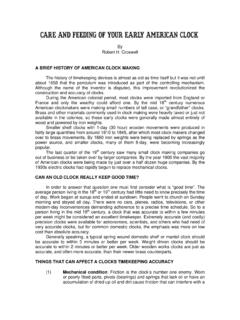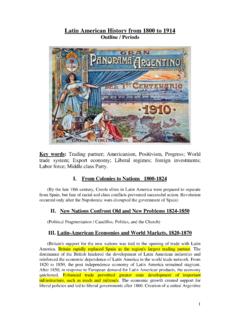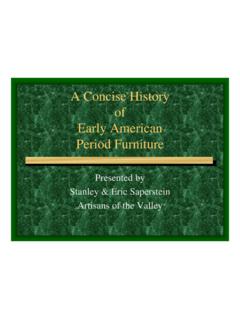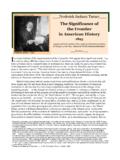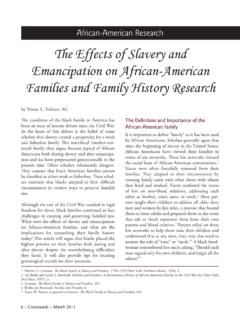Transcription of THE HISTORY OF NURSING HOMES
1 THE HISTORY OF NURSING HOMES In the twenty-first century, NURSING HOMES have become a standard form of care for the most aged and incapacitated persons. Nearly 6 percent of older adults are sheltered in residential facilities that provide a wide range of care. Yet such institutions have not always existed; rather, their HISTORY and development reflect relatively recent demographic and political realities that shape the experience of growing old. Before the nineteenth century, no age-restricted institutions existed for long-term care. Rather, elderly individuals who needed shelter because of incapacity, impoverishment, or family isolation often ended their days in an almshouse. Placed alongside the insane, the inebriated, or the homeless, they were simply categorized as part of the community's most needy recipients. In the beginning of the nineteenth century, women's and church groups began to establish special HOMES for the elderly persons.
2 Often concerned that worthy individuals of their own ethnic or religious background might end their days alongside the most despised society, they established as the founder of Boston's home for Aged Women (1850), explained a haven for those who were "bone of our bone, and flesh of our flesh". Advocates for these asylums contrasted their benevolent care with the horrors of those who were relegated to the almshouse. "We were grateful," wrote the organizers of Philadelphia's Indigent Widows' and Single Women's Society, one of the nation's earliest old age HOMES , in 1823, "that through the indulgence of Divine Providence, our efforts have, in some degree, been successful, and have preserved many who once lived respectfully from becoming residents of the Alms House". Although designed for those without substantial familial support, these early HOMES still generally required substantial entrance fees and certificates of good character.
3 Through these policies, the founders strove to separate their own needy poor from, as the Boston founder explained, foreigners who "have taken possession of the public charities..as they have of the houses where our less privileged classes formerly resided". Not surprisingly, perhaps, throughout the nineteenth century the numbers of elderly people who found shelter in these institutions was rather limited. In 1910 the state of Massachusetts, reported that 2,598 persons resided in such asylums. The great majority of these individuals were widowed and single women who had lived their entire lives, or at least a great proportion, as citizens of the state. Although the institutions were hardly palatial, the amount spent on each resident was far greater than the allocation for each almshouse resident. Much as their founders had hoped, the nineteenth-century old-age home operated to differentiate the "worthy" old of a particular religion or ethnic group from the most needy and desperate of the aged population.
4 As a result, for the most impoverished individuals, the almshouse still served as the last refuge in their old age. Throughout the nineteenth century, in fact, this institution appeared to play an increasingly important part in the long-term care of the old. Some states, such as Pennsylvania, periodically revoked outdoor relief in the form of money, wood, or clothes, demanding that those in need either struggle on their own or enter an almshouse. Moreover, as charity advocates removed other, younger paupers to institutions organized to specific needs such as orphanages, work HOMES , hospitals, or insane asylum elderly persons became the dominant almshouse residents. Thus, although the proportion of the elderly population that was institutionalized remained stable at about 2 percent, the percentage of elderly within almshouses soared. In 1880, 33 percent of the national alms-house population was composed of elderly individuals, but by 1923 the proportion had increased to 67 percent.
5 Many of the superintendents of state and local institutions responded to the changing nature of their residents by altering the names of their asylums. In New York City, in 1903, the Charity Board renamed its public almshouse the home for the Aged and Infirm. The city of Charleston followed suit in 1913, transforming their almshouse into the Charleston home . In these institutions, their managers claimed, the old could find everything they needed in their last days. Despite the name changes and the rosy descriptions that filled the institutions' annual reports, most people hardly looked upon the almshouse as a satisfactory solution to the demands for long-term care for the elderly. Throughout the early twentieth century, the institution remained a symbol of failure and despair. Poorhouse, according to early twentieth-century social analyst Harry C. Evans, was "a word of hate and loathing, for it includes the composite horrors of poverty, disgrace, loneliness, humiliation, abandonment, and degradation" (Epstein, p.)
6 218). Often pointing to the rising percentage of aged individuals within these institutions as proof of increased dependency, pension advocates such as Abraham Epstein repeatedly argued that such institutions clearly revealed the inability of elderly persons to succeed in the industrial world. The almshouse, Epstein wrote in 1929, "stands as a threatening symbol of the deepest humiliation and degradation before all wage-earners after the prime of life" (p. 128). By the 1930s, government officials accepted the argument that the rising proportion of elderly persons in almshouses was a sign that older people could no longer compete in the modern world. According to a government study in the 1930s, "the predominance of the aged in the almshouse is a sign of their increasing dependency" (United States Social Security Board). Despite the fact that the percentage of aged individuals who required such care appeared rather stable, both the tangible horrors of the almshouse and the rising percentage of aged individuals within such institutions convinced officials that radical measures needed to be taken.
7 Moreover, many were sure that the almshouse had become a costly solution to the needs of the old. Assuming that all elderly individuals would eventually need support, they argued that small pensions were a less expensive solution. In the movement to establish the Social Security program, therefore, concerns about the almshouse's central function in providing long-term care played an essential role. Hoping to eliminate the institution entirely, pension advocates barred any almshouse resident from receiving old-age support. "We were," wrote Pennsylvania's deputy secretary of public assistance, "rather enthusiastic to empty the poorhouses" (Thomas, p. 97). Although individuals who resided in a privately funded institution could be beneficiaries of pensions, almshouse residents were barred from such payments. This proviso was essential for establishing both the popularity and legitimacy of Social Security legislation.
8 In asserting the constitutionality of the Social Security Act (1935), Supreme Court Justice Benjamin Cardozo, writing for the majority, proclaimed that "the hope behind this statute is to save men and women from the rigors of the poorhouse as well as the haunting fear that such a lot awaits them when the journey's end is near" (Haber and Gratton, p. 139). To a large degree, many of the pension advocates had overestimated the impact of pensions on the lives of the needy elderly. Most had simply assumed that, with monthly annuities, individuals could live independently. They saw little reason to reform the poorhouse or support it with financial resources. A few, however, such as aging advocate Homer Folks, argued that only about 15 percent of the almshouse population were in the institution because of strict financial need. "The others," he explained, "are physically infirm and sick, and have various kinds of ailments that require personal attention of the kind that you could not get in an individual home ; [they] require NURSING or medical attention.
9 In some sort of institution" (Thomas, p. 40). Nonetheless, the symbol of the almshouse was so powerful that Folks's argument had little public support. Despite its relatively small inmate population, the almshouse stood as a tangible sign of a despised welfare system. There seemed little doubt that it needed to be eliminated. In eradicating the almshouse, therefore, pension legislation had an unforeseen consequence. By barring almshouse inmates from payments, aged individuals in need of long-term care were forced to seek shelter in private institutions. In Charleston, for example, while some of the almshouse residents were able to leave the institution and, with the support of pensions, live on their own, many were compelled to enter private, often unregulated, sanitariums. In some cases, such a move was more a change in name than in place. In Kansas, for example, immediately following the enactment of Social Security, officials transferred well-established county HOMES into private control, although neither the residence nor its supervisors changed.
10 Most importantly, however, the inmates could now be classified as recipients of private care, and the institution was able to receive residents' monthly annuities. By the 1950s, the intent of policymakers to destroy the hated almshouse had clearly succeeded. Most poorhouses had disappeared from the landscape, unable to survive once their inmates no longer received federal annuities. As a result, and due to the lobbying of public hospital associations, Congress amended Social Security to allow federal support to individuals in public facilities. New legislation, including with the Medical Facilities Survey and Construction Act of 1954, allowed for the development of public institutions for the most needy older adults. For the first time, both public and private NURSING - home residents were granted federal support for their assistance. As Homer Folks had predicted, not all elderly individuals could be supported in their own HOMES with monthly pensions; many incapacitated older adults required long-term care.

